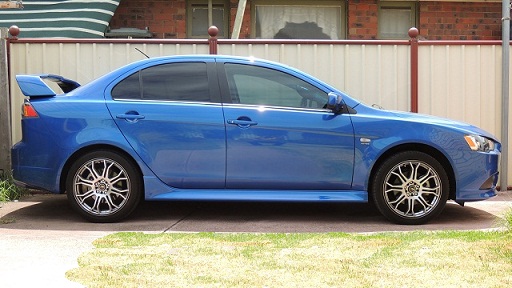***** ALERT - Nominations for your new ClubCJ Committee can be made here *****
should speed limits be raised
Moderators: Moderators, Senior Moderators
-
scott_drake
- Lancer VRX/GTS

- Posts: 453
- Joined: Thu Sep 30, 2010 1:46 pm
- Location: world wide
- shadow-vex
- Lancer Evolution

- Posts: 873
- Joined: Thu Jun 27, 2013 6:29 pm
- Location: camden
- jordan.fuchs
- Lancer Ralliart

- Posts: 705
- Joined: Mon Feb 11, 2013 1:00 pm
I can't think of a road in NSW that would be safe having a speed limit of over 110 stretches of the m5 maybe but not as a constant speed.
If they raise the speed limit to 130, then the L platers and P platers need a relative speed limit raise. Imagine flying down the highway at 130 when all of a sudden an L plater doing 90 appears over the hill you're going to have to swerve pretty quickly and swerving at such a high speed will result in accidents.
I know we're only talking 10-20km/h but that makes a huge difference.
If they raise the speed limit to 130, then the L platers and P platers need a relative speed limit raise. Imagine flying down the highway at 130 when all of a sudden an L plater doing 90 appears over the hill you're going to have to swerve pretty quickly and swerving at such a high speed will result in accidents.
I know we're only talking 10-20km/h but that makes a huge difference.
- jordan.fuchs
- Lancer Ralliart

- Posts: 705
- Joined: Mon Feb 11, 2013 1:00 pm
TrojanHorse wrote:If its a highway, wouldnt it generally be flat and straight? Therefore visibility should be fine and the above shouldnt be an issue.
That's generally the idea, however the M5 in sydney is a bit of a nightmare at the moment from Campbelltown through to the city (they are upgrading it at the moment though, so it should be better in the coming years, however it's still not a straight road.
- quagmire01
- Lancer Newbie

- Posts: 87
- Joined: Sat May 26, 2012 3:25 pm
- Location: Cranbourne, Victoria
Hi all. At the risk of getting rocks thrown at me, I will wade in on this with a slightly different bent. My background is in Civil Engineering and Geo-Spatial Information Systems. The issue we have (at least here in Victoria anyway, is the actual design of the roads themselves. The road surfaces down here are only rated to a certain speed limit (130 max) and beyond that you start to suffer from split friction surfaces (known as polishing), which reduces the friction and speed tolerances again.
Given that a LOT of people travel over the posted speed limit, the issue you have is that for every 5km/h over the maximum rating of the road surface, your chances of tyre separation, particularly on the split friction surfaces, increases dramatically. Please don't get me started on four wheels drives.
So, by raising the speed limit to 130kph in Victoria you remove ALL leeway and safety buffers for road wear etc.
There is no point comparing us to Europe etc as the road design standards are different. I know there is an argument about the open speed limits in the NT but once again road designs are different due to the different traffic it carries (road trains etc).
Freeways, in my opinion, should be 110. This allows for safety buffers as the road surface wears.
I will also not start on the quality of road maintenance here in Victoria, or infrastructure issues full stop. I will be typing for 3 hours lol.
Am standing by to be flogged for my comments. I am speaking purely from fact and my background in road and bridge design. Nothing more. Sorry.
Given that a LOT of people travel over the posted speed limit, the issue you have is that for every 5km/h over the maximum rating of the road surface, your chances of tyre separation, particularly on the split friction surfaces, increases dramatically. Please don't get me started on four wheels drives.
So, by raising the speed limit to 130kph in Victoria you remove ALL leeway and safety buffers for road wear etc.
There is no point comparing us to Europe etc as the road design standards are different. I know there is an argument about the open speed limits in the NT but once again road designs are different due to the different traffic it carries (road trains etc).
Freeways, in my opinion, should be 110. This allows for safety buffers as the road surface wears.
I will also not start on the quality of road maintenance here in Victoria, or infrastructure issues full stop. I will be typing for 3 hours lol.
Am standing by to be flogged for my comments. I am speaking purely from fact and my background in road and bridge design. Nothing more. Sorry.
- squala
- Post Monster

- Posts: 2869
- Joined: Wed Jun 03, 2009 12:23 am
- Location: Fines City, VIC, Australia
Yes, they should raise speed limits, at least for 4WD cars! 
Seriously though, 130 kph is the ideal average speed on long highways. Autobahns recommend this speed for normal driving, but of course, they are free to go (a lot) faster than that. 110 kph can really cause drowsiness, especially in today's cars where the speed feels slower than you're actually travelling.
Seriously though, 130 kph is the ideal average speed on long highways. Autobahns recommend this speed for normal driving, but of course, they are free to go (a lot) faster than that. 110 kph can really cause drowsiness, especially in today's cars where the speed feels slower than you're actually travelling.
///// /////
7 airbags
6-speed SST
5-star safety
4-wheel drive
3-diamond badge
2 overhead cams
1 awesome ride
0 demerit points and gutter rash

7 airbags
6-speed SST
5-star safety
4-wheel drive
3-diamond badge
2 overhead cams
1 awesome ride
0 demerit points and gutter rash

- shadow-vex
- Lancer Evolution

- Posts: 873
- Joined: Thu Jun 27, 2013 6:29 pm
- Location: camden
allen, ill throw a rock at u, so to speak. if highways were made to a better standard would 130km/h be good, because the amount of time spent doing dodgey repairs doesn't seem to be very helpful so instead of a temporary fix, if roads were made better, would 130 be a good speed because the quality of the road is better, or will aus never get any better

Boost life scrambles the brain
- quagmire01
- Lancer Newbie

- Posts: 87
- Joined: Sat May 26, 2012 3:25 pm
- Location: Cranbourne, Victoria
Hi Josh, good question mate. Essentially it comes down to $$$. I am not sure what other states are like but here in Victoria the trend is to do rolling repairs of areas identified as being in the greatest need. Likewise, intersection upgrades are often completed as a result of prioritising due to high trauma areas (rather than fix it before collisions happen, fix after we've had a few).
If the road surfaces where of a higher standard THAT COULD BE MAINTAINED, then there would be some wiggle room.
Two of the biggest issues we have down here are polishing (smooth tracks in the road surface caused by traffic flow) and sinking of the sub base (results in ruts being caused with raised edges due to bitumen pushing down and outwards). The last one is common on heavy vehicle routes where there is braking at speeds over about 90 kph, especially during summer.
The issue with the polishing is a big one and is a contributing factor to collisions. Particularly in the wet. To para-phrase Newtons 2nd law of physics, essentially the differential in momentum of an object is directly proportionate to the forces acting on it, in this case we are talking about the friction value of the road surface. A vehicle is travelling on the wet road and has two wheels on the polished surface and two wheels on an unpolished surface (this is very common). The unpolished surface has a friction value of about, say, 0.75 (common value). The polished surface has a friction value of about, say, 0.5 (common value). if the vehicle suddenly brakes, two tyres grip at different rates which causes one side of the vehicle to slow faster than the other. This will often cause the vehicle to begin to rotate and yaw across the road surface. Once in a yaw effective braking is reduced so very little speed is washed off compared to a straight line skid. The vehicle now yaws out of control and crashes.
All of this is compounded if the vehicle is travelling about the maximum safe speed rating for the road surface.
So, if we are able to build roads that have a speed rating, of say, 150kph to allow for a safety buffer, and these road were able to be MAINTAINED at this rating, then there is a chance that the speed limit could be raised.
However, all of the infrastructure upgrading required would cost big $$$.
Not to mention the road works required. It is a logistical nightmare I guess
If the road surfaces where of a higher standard THAT COULD BE MAINTAINED, then there would be some wiggle room.
Two of the biggest issues we have down here are polishing (smooth tracks in the road surface caused by traffic flow) and sinking of the sub base (results in ruts being caused with raised edges due to bitumen pushing down and outwards). The last one is common on heavy vehicle routes where there is braking at speeds over about 90 kph, especially during summer.
The issue with the polishing is a big one and is a contributing factor to collisions. Particularly in the wet. To para-phrase Newtons 2nd law of physics, essentially the differential in momentum of an object is directly proportionate to the forces acting on it, in this case we are talking about the friction value of the road surface. A vehicle is travelling on the wet road and has two wheels on the polished surface and two wheels on an unpolished surface (this is very common). The unpolished surface has a friction value of about, say, 0.75 (common value). The polished surface has a friction value of about, say, 0.5 (common value). if the vehicle suddenly brakes, two tyres grip at different rates which causes one side of the vehicle to slow faster than the other. This will often cause the vehicle to begin to rotate and yaw across the road surface. Once in a yaw effective braking is reduced so very little speed is washed off compared to a straight line skid. The vehicle now yaws out of control and crashes.
All of this is compounded if the vehicle is travelling about the maximum safe speed rating for the road surface.
So, if we are able to build roads that have a speed rating, of say, 150kph to allow for a safety buffer, and these road were able to be MAINTAINED at this rating, then there is a chance that the speed limit could be raised.
However, all of the infrastructure upgrading required would cost big $$$.
Not to mention the road works required. It is a logistical nightmare I guess
quagmire01 wrote:Not to mention the road works required. It is a logistical nightmare I guess
So the real question is...
"How much are you willing to pay in yearly rego fees to have higher FWY speed limits?"
And think about it, the Germans had to drive their tanks around town all those years back so their road infrastructure needed to be top notch.
World Domination isn't cheap.
Signature For Lease - Apply Within
- quagmire01
- Lancer Newbie

- Posts: 87
- Joined: Sat May 26, 2012 3:25 pm
- Location: Cranbourne, Victoria
The other point that I eluded to above is the maintenance of the roads once they are built to the standard you all desire. If the roads are allowed to degraded as they do now, then they become unsafe for travel at the speed you all want. Given that we are currently the 3rd(?) most litigious nation in the world, what do you think will happen when Johnny Smith is scooting along the freeway at his "ideal" speed of 130 and he suffers from tread separation with the road due to split friction values caused by lack of maintenance? That's right...... he will sue. "But the sign says 130 so I was doing 130. It's not my fault the road is poor. You should have maintained it so I could keep doing 130". Sorry but I can tell you from first hand experience that it can and does happen, regularly.
This is one of the reasons why road maintenance authorities have an annoying habit of leaving the speed restriction signs up when not working. There was a case where they took them down 9trying to do the right thing) and a woman fell off the road. She then sued (and won) claiming negligence in that the signs should have been left up so that she would drive slowly. Apparently "driving to the road conditions" was not a thought that entered her head. "Hey, the sign said 100 so I did 100. You should have held my hand".
Sorry to be a kill-joy folks. I am just trying to add another (often unconsidered) dimension to the discussion. Albeit at my own expense in making me the most unpopular person on the site.
This is one of the reasons why road maintenance authorities have an annoying habit of leaving the speed restriction signs up when not working. There was a case where they took them down 9trying to do the right thing) and a woman fell off the road. She then sued (and won) claiming negligence in that the signs should have been left up so that she would drive slowly. Apparently "driving to the road conditions" was not a thought that entered her head. "Hey, the sign said 100 so I did 100. You should have held my hand".
Sorry to be a kill-joy folks. I am just trying to add another (often unconsidered) dimension to the discussion. Albeit at my own expense in making me the most unpopular person on the site.
- shadow-vex
- Lancer Evolution

- Posts: 873
- Joined: Thu Jun 27, 2013 6:29 pm
- Location: camden
Who is online
Users browsing this forum: No registered users and 24 guests
